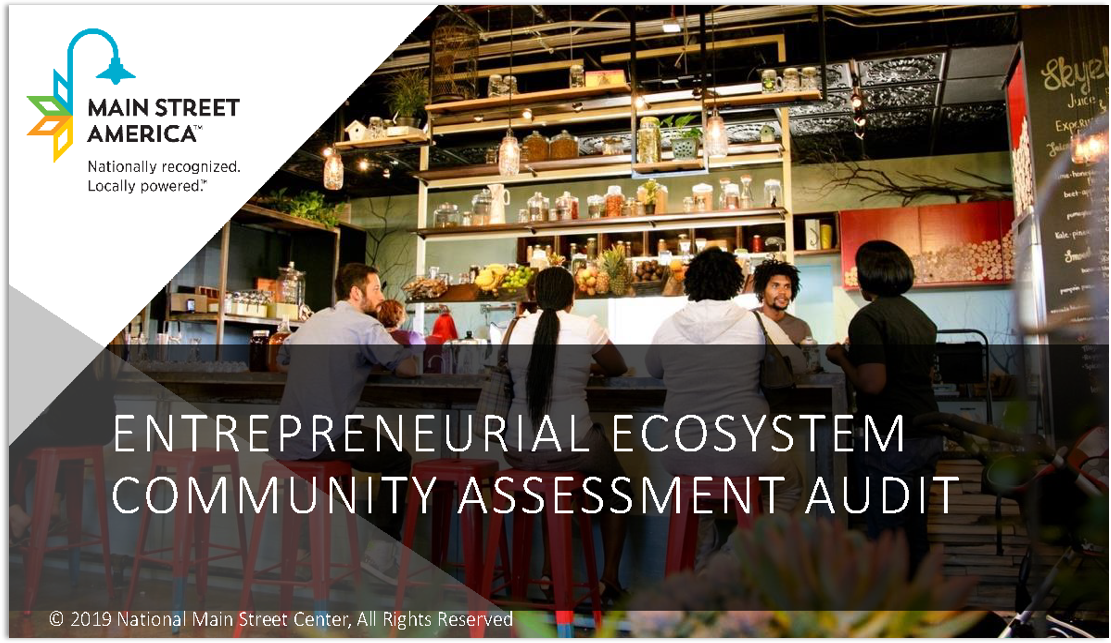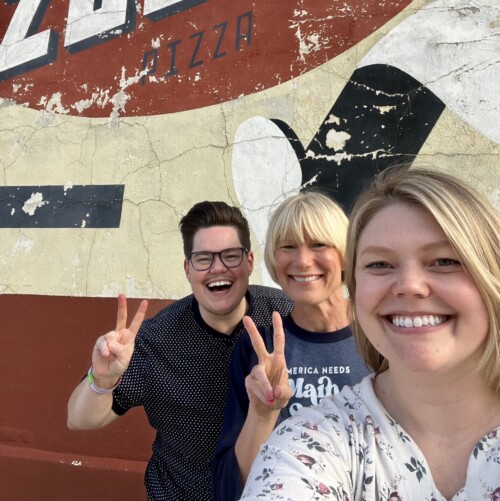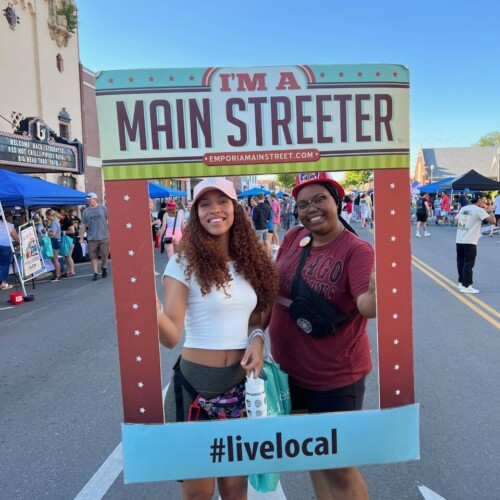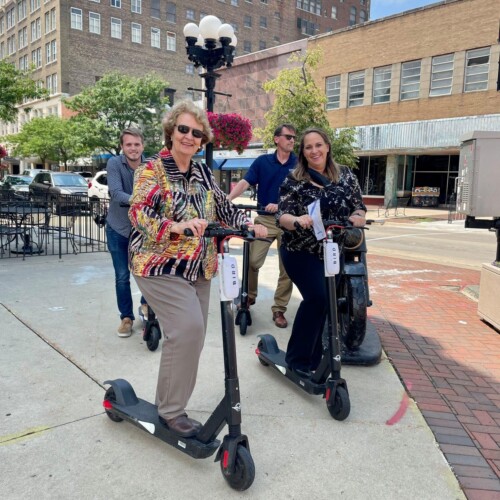June 9, 2020 | COVID-19 Trends Blog Series: COVID-19 Likely to Result in Increased Entrepreneurship Rates | By: Matthew Wagner, Ph.D., Vice President of Revitalization Programs, NMSC |  In 2012, Beverly Crossen opened Farmhouse, a diy boutique, workshop space, and working custom studio, in Tupelo, Mississippi.
In 2012, Beverly Crossen opened Farmhouse, a diy boutique, workshop space, and working custom studio, in Tupelo, Mississippi.
This article is part of the COVID-19 Trends Blog Series.
Despite the more than 40 million unemployment filings and anticipated millions of small business closures that will result due to COVID-19, previous economic downturns suggest that there may soon be ripe opportunities for business start-up activity.
Prior to COVID-19, the single biggest economic downturn, other than the Great Depression, was the appropriately titled “Great Recession” of 2007-2009. During that time, government unemployment statistics show 8.8 million people lost their jobs and thousands of businesses closed or filed bankruptcy. However, it also resulted in a sizable increase in rates of entrepreneurship. In “How the Great Recession Spurred Entrepreneurship” by Robert Fairlie, Ph.D., data from 250 regions across the US demonstrated higher local unemployment rates were tied to higher rates of entrepreneurship. The unemployed started more businesses than those who held a job. In fact, entrepreneurship rose by 17 percent from 2006 through 2009. The rise of entrepreneurship also suggests a general lag between job losses and start-up activity, as many of those faced with unemployment may first search for a new job rather than start a new firm. We may find a similar lag from COVID-19-related economic impacts, but given the magnitude of unemployment, it may happen more quickly and in greater numbers.
Fairlie’s findings were further supported by The Economic Future Just Happened by Dane Stangler of the Ewing Marion Kauffman Foundation. In analyzing data from the U.S. Census, the Fortune 500, and the Inc. list of America’s fastest-growing companies, the study finds:
A critical component to this trend will be the availability of capital resources. During the Great Recession, much of the entrepreneurial recovery was driven not by bank lending but by the growth of home equity, which enabled entrepreneurs to access home equity loans to launch. Many also tapped their retirement benefits. On the issue of home equity, given the decline in home ownership (down to 64% in 2018 from 70% in 2005 pre-Great Recession) it is unlikely that entrepreneurship will be totally driven by home equity loans. Like PPP lending, instead entrepreneurs may seek from more community banks, Fintech institutions and Certified Development Financial Institutions (CDFIs). In terms of retirement savings, the CARES Act did away with the early withdrawal penalty up to $100,000 from personal retirement savings for those impacted by COVID19. Thus, that will likely drive some start-up activity.
Interestingly, the types of businesses formed during the downturn are similar to those started in prosperous periods. In fact, the share of businesses created in each industry during boom and bust periods differs by less than a percentage point. The highest number of startups during the Great Recession appeared in the professional-services and construction sectors, followed by education and health services, wholesale, and retail. Manufacturing had the lowest rate.
It’s important to note that since the Great Recession much has changed in the rates of manufacturing start-ups. Launching a manufacturing business was historically the most capital-intensive business to start, and thus impacted rates of entrepreneurship in this industry. However, over the past decade, a combination of decreasing costs and access to equipment, logistics, and ability to reach consumers through e-commerce have lowered the barriers for “Small-scale Producers” to launch in nearly every retail sector. This has closely aligned with consumer interest in unique crafted products, the growth of platforms like Etsy, and economic development efforts to support maker spaces and shared food kitchens.
Insights for Main Streets
While COVID-19 has delivered far greater numbers in job losses and likely business closures, past trends suggest Main Streets should anticipate a corresponding trend line relative to the growth in entrepreneurship. As such, from a Main Street programming perspective, we should plan to examine our Economic Vitality work in support of both new entrepreneurs, but also the entrepreneurial thinking that will be required from transitioning existing small businesses.
Given the early nature of the pandemic fallout, it is very difficult to extrapolate in exact terms COVID-19-related impacts in levels of new entrepreneurs. History certainly suggests a large increase is expected, especially given economist predictions like that of University of Stanford economist Nicholas Bloom, who suggests in a recent study that 42 percent of recent job losses will be permanent.
Unlike past recessions/depressions, COVID-19 will also require changes for existing businesses in a way that will require new entrepreneurial thinking. This may require existing small businesses to rethink everything from their business models, revenue channels, product/service offerings, and other adaptations to COVID-19-related shifts in shopping, working, and recreating.
As Main Streets examine their recovery planning, the likely macro trend in entrepreneurship rates suggests we should be considering the following shifts or increased focus on the following: 1. Entrepreneurship Ecosystem Development – Main Street programs play a critical role in supporting the launch, growth, and sustainability of small businesses. This role has centered on technical assistance, connections to financial resources, and most importantly, creating the environment and place-based activities that support entrepreneurs. Place-based entrepreneurial development includes activities ranging from sponsoring pop-ups to creating alleyway conversions for outdoor dining to supporting maker spaces. Main Street America has created a number of resources to help in guiding this process, including an audit tool to better understand the current support system for entrepreneurs.
1. Entrepreneurship Ecosystem Development – Main Street programs play a critical role in supporting the launch, growth, and sustainability of small businesses. This role has centered on technical assistance, connections to financial resources, and most importantly, creating the environment and place-based activities that support entrepreneurs. Place-based entrepreneurial development includes activities ranging from sponsoring pop-ups to creating alleyway conversions for outdoor dining to supporting maker spaces. Main Street America has created a number of resources to help in guiding this process, including an audit tool to better understand the current support system for entrepreneurs.
2. Developing and/or Growing Your Relationship with Small Business Development Centers (SBDC) – Work with your local SBDC office. Many of you may be familiar with the CARES Act provision that provided $265 million to SBDCs, along with Women and Minority Business Centers. In discussions with the SBA’s Office of Entrepreneurial Development, there is an excellent opportunity to leverage this funding through your State SBDC offices to support local technical assistance, counseling and programming for Main Street businesses, and potentially as part of programming expense offsets for your local organizations. Other entities like community and technical colleges are also anticipated to see a rapid increase in enrollments as a result of layoffs. They can be excellent partners in transitioning students not only to new jobs, but also to new entrepreneurial opportunities resulting from new skills in areas such as culinary, welding, CNC, and other skilled trades that can have a retail connection through small-scale production.
3. Updating your Real Estate Inventories – As place assets become ever more important components in support of your local entrepreneurial ecosystem, building amenities, characteristics, infrastructure, etc. can be helpful in matching the needs of new entrepreneurs to real estate that provides a best fit. In addition, given the likely fall-out with vacancies, it is important to understand how your property owners are rethinking their leasing models, and the potential for creating greater transparency and “partnering” in lease arrangements, whether that is through percent sale agreements, or step up clauses. This is also an area in which Main Streets and/or other partner organizations could play a role by sponsoring Rental Gap assistance by making up the difference between stated rental rates and what the entrepreneurs’ business plan will enable them to afford as they ramp up their businesses.
4. Understanding your Market Position – At any time, but particularly when resources and capacity are scarce, it is important to understand your key consumers and business niches. If you have Transformation Strategies, have they been altered due to COVID-19? After examining any shifts, outline where you have new business opportunities and how they are aligned to your vacancies. Continue with building out your pipelines, like hosting pitch-it contests and pop-ups that target entrepreneurs who match and support your market position. Check out our Market Analysis Guide for Community Transformation here.
5. Becoming Familiar with Start-Up Financing Alternatives – A silver lining to issues with the PPP program has been the support demonstrated through other financial options, like community banks, CDFIs, and Fintech. In fact, this past week, an additional $10 billion allocation was made to CDFIs from the federal government. Given the likely issues in leveraging home equity, a tool many entrepreneurs used in the Great Recession, entrepreneurs and those that help to connect resources will need to expand their knowledge and use of various start-up capital tools. Also, if you have existing grants and/or loan programs, consider short-term shifts to their direction that make more strategic sense.
6. Working with Existing Businesses to Become “New” Entrepreneurs – COVID-19 has resulted in a number of short-term and perhaps long-term shifts in consumerism. We have become much more used to delivery and pick-up for example, increased our online shopping, and developed new habits around everything from cooking at home to biking on local trails. For millions of existing small businesses, these new “norms” will require an examination of their current business model, revenue streams, access to markets through multiple channels, shifts in interior design, and perhaps even shifts in their product offerings. In many ways, they will need to become “new” entrepreneurs all over again and may need very similar kinds of services to guide them through this strategic planning effort. To assist, consider forming small business recovery teams made up of local service providers and SBDC counselors and provide connections to specific resource needs. You could also create a small business recovery inventory of web-based resources to share with your small businesses, including topics ranging from how to launch a website to rebranding your business.
Looking back at trends is a great predictor of future direction, albeit not an exact science. Past data demonstrates that in bad economic times that have forced business closures and resulted in large unemployment numbers, the silver lining has been the counter rise in entrepreneurship. Despite all the challenges, there is a need for optimism. For many Americans, the new potential lies ahead to launch a new business or recover stronger as an existing business from the pandemic. As they have for the past 40 years, Main Streets, will be better positioned to positively impact their district recovery efforts by repositioning and aligning resources and activities to this need.
Disclaimer: This material has been prepared for informational purposes only and is not intended to provide, and should not be relied on for legal, insurance, liability, tax, or accounting advice. You should consult your own legal, insurance, tax, and accounting advisors for guidance on these matters.
Meet the Author
 Matthew Wagner, Ph.D., Vice President of Revitalization Programs: Matthew Wagner, Ph.D. serves as Vice President of Revitalization Programs at the National Main Street Center, Inc. In this role, he is responsible for driving the Center’s field service initiatives including the development and delivery of technical services for Main Street America and Urban Main programs, directing the Center’s new research agenda, as well as professional development programming through the Main Street America Institute.
Matthew Wagner, Ph.D., Vice President of Revitalization Programs: Matthew Wagner, Ph.D. serves as Vice President of Revitalization Programs at the National Main Street Center, Inc. In this role, he is responsible for driving the Center’s field service initiatives including the development and delivery of technical services for Main Street America and Urban Main programs, directing the Center’s new research agenda, as well as professional development programming through the Main Street America Institute.
Read Matthew's bio.




